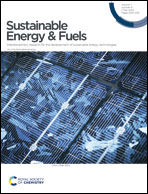Upcycling of spent lithium-ion battery graphite anodes for a dual carbon lithium-ion capacitor†
Abstract
Lithium-ion capacitors (LICs) are hybrid devices that combine the properties of both high-energy lithium-ion batteries (LIBs) and the high power and cyclability of electric double-layer capacitors (EDLCs) in a single-unit device. Sustainable electrode materials are of utmost importance for energy storage and conversion systems. Herein, graphite anodes from spent LIBs are used as the source of anode and cathode materials in a LIC through modification in post-purification treatment methods. A graphite–graphene composite derived from the spent LIB graphite is fabricated as an anode delivering ∼320 mA h g−1 for 1000 cycles at 1 A g−1. The composite utilizes the structural stability and long cycle life of graphite and the high rate capability and increased storage capacity of graphene. In contrast, surface-activated recycled graphene used as a potential capacitive cathode exhibited 84% capacitance retention at the end of 5000 cycles. The LIC full cell assembly using a pre-lithiated recycled graphite–graphene composite as a battery-type anode and activated graphene nanosheets as a capacitive cathode delivers energy densities of 135 and 74 W h kg−1 at power densities of 300 and 15 000 W kg−1, respectively. The LIC full cell cycles for 10 000 cycles with ∼70% capacitance retention. The feasibility and degradation mechanism of the LIC cell are studied through leakage current, self-discharge, electrochemical impedance spectra, and postmortem X-ray diffraction.

- This article is part of the themed collection: Hybrid Ion Capacitors


 Please wait while we load your content...
Please wait while we load your content...